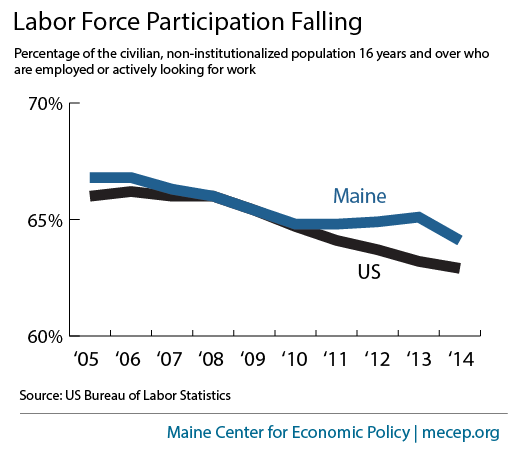Maine’s labor force participation was 64.1% in 2014, down from 65.1% in 2013, according to model-based estimates from the Labor Department released earlier this year. Maine’s 2014 decline was one of the largest in the nation. The estimates come from the US Labor Department’s Local Area Unemployment Statistics (LAUS) program, based on a monthly survey of fewer than 2,000 Maine households. LAUS is the longstanding source for official estimates of the state’s unemployment and labor force participation rates.
The labor force participation rate is simply the percentage of civilian non-institutionalized people over the age of 16 who are either employed or actively searching for work. It’s an important economic statistic because it tells us the size of the labor supply and because it affects the official unemployment rate. The fall in Maine’s labor force participation rate isn’t surprising. What’s surprising is how long it took to materialize.
It has more to do with the aging of Maine’s population than with the health of the state’s economy. One of the mysteries of the post-recession period in Maine was the growth in the state’s labor force participation rate relative to the rest of the nation. While the US rate has declined steadily since 2008, Maine’s rate stopped falling in tandem with the US in 2010 and actually rose slightly from 2010 to 2013. Over that three-year period, only the District of Columbia had a larger increase in the share of population employed or looking for work.
This was hard to explain, for at least two reasons. First, it didn’t make sense given our demographic profile. Many analysts, including several at regional federal reserve banks, have attributed much of the national decline in labor force participation to demographic factors, especially the baby boom generation’s aging out of their prime working years. Since Maine has the nation’s highest median age and one of the largest cohorts of baby boomers, it seemed weird that our labor force participation rate was growing faster than all the other states.
It also didn’t make sense given Maine’s lackluster job growth rate. We know from administrative payroll records that Maine added only about 8,700 payroll jobs from 2010 to 2013. But the same model that LAUS uses to estimate the labor force participation rate shows that the number of Mainers who were employed grew by more than 21,000 over the same three-year period. Yes, some newly employed Mainers weren’t showing up in the payroll job count because they were commuting to out-of-state work or starting their own businesses. But these factors seem too small to explain such a large difference.
Maine’s labor force participation rate peaked at 68% fifteen years ago, in 2000. At that time, we were riding a boom in the economy and Maine’s baby boomers were all in their working prime. Expect to see Maine’s labor force participation rate continue to decline in the coming years as more and more baby boomers retire. It may be a very long time before Maine returns to pre-recession rates of labor force participation.



